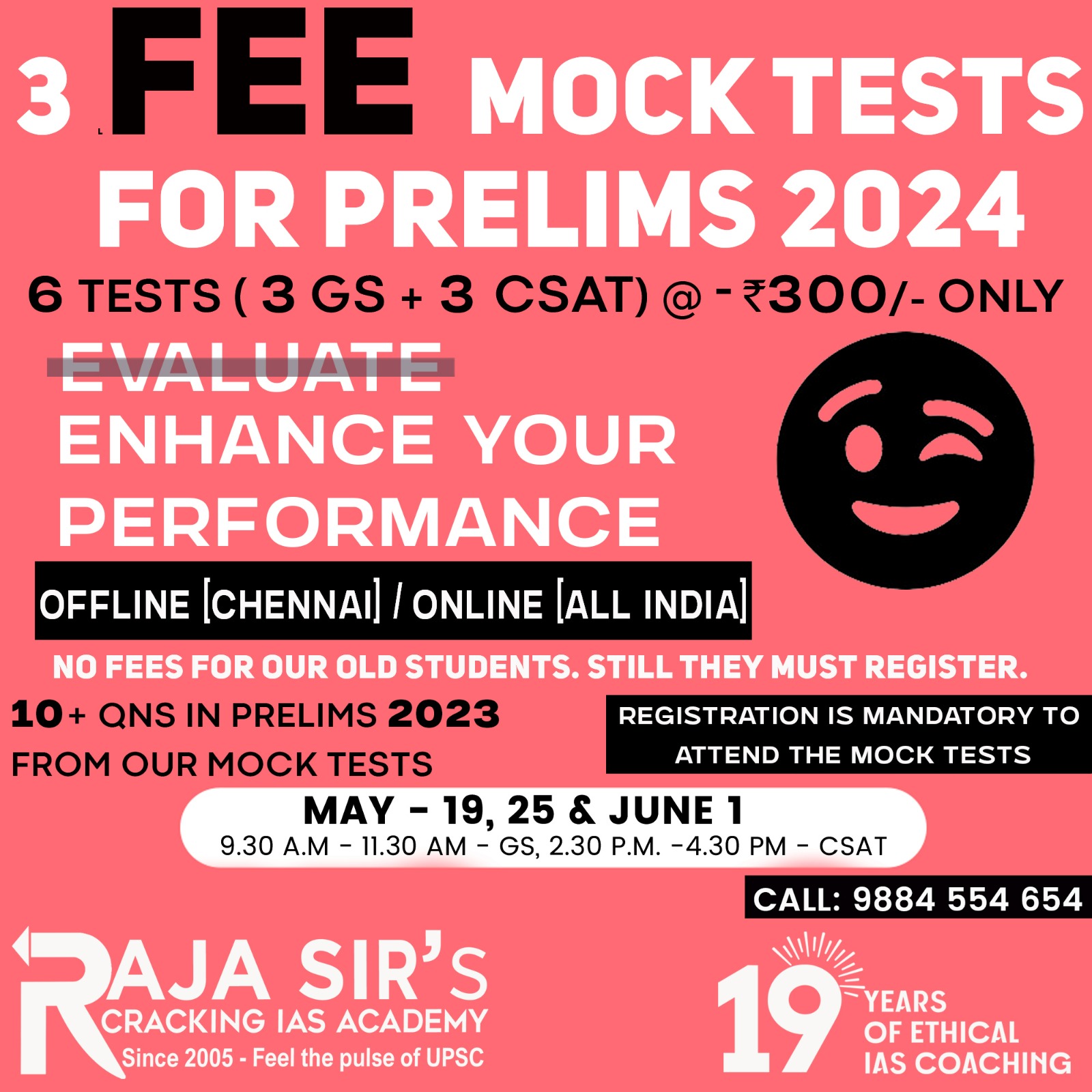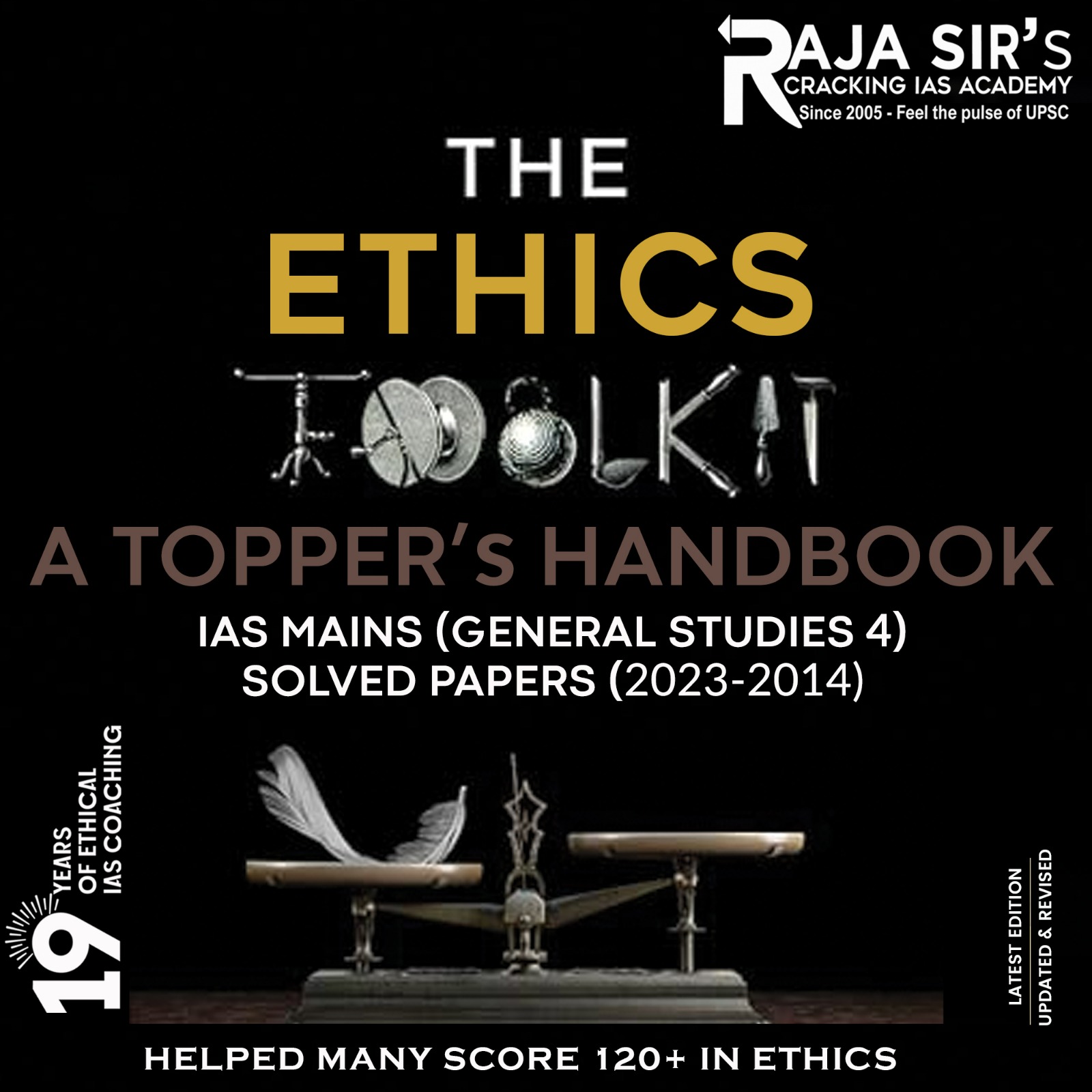- Home
- Prelims
- Mains
- Current Affairs
- Study Materials
- Test Series
 EDITORIALS & ARTICLES
EDITORIALS & ARTICLES
Hit List Questions 30 -PPP 100 PRELIMS 2024 - 48
Questions & Explanations:
|
1. |
Consider the following statements about the five-year plans of India: 1. Garibi Hatao desh bachao was included in fifth five-year plan. 2. The sixth five-year plan (1980-1985) marked a shift in pattern of industrialization from heavy industries to infrastructure. 3. The seventh five-year plan saw the emergence of outward looking strategy with exports receiving high priority. 4. There was a two-year plan holiday between the years 1990-1992. Which of the above statement/s is/are correct? (a) 1 and 2 only (b) 3 only (c) 1, 2, 3 and 4 (d) 1, 2 and 4 only
|
|
||||||||||||||||||||||||||||||||
|
2. |
Consider the following statements: 1. Though Parliament’s power to amend the constitution is limited power, it can be enlarged into absolute power. 2. Besides the Supreme Court, the President can also decide whether any matter forms a part of the basic structure of the Constitution. Which of the statements given above is/are correct? (a) 1 only (b) 2 only (c) Both 1 and 2 (d) Neither 1 nor 2
|
|
||||||||||||||||||||||||||||||||
|
3. |
Consider the following w.r.t. Nipah virus: 1. It is carried by fruit bats. 2. It belongs to the same family of paramyxoviruses as more well-known pathogens like measles. 3. It is an RNA virus. 4. It spreads more slowly than SARS-CoV2. Select the correct statements. (a) 1, 3, 4 (b) 1, 2 (c) 1, 2, 3, 4 (d) 1, 2, 4
|
|
||||||||||||||||||||||||||||||||
|
4. |
H. pylori infections primarily affect (a) Cardiac muscles (b) Stomach (c) Liver (d) Brain
|
|
||||||||||||||||||||||||||||||||
|
5. |
Initiative for Critical and Emerging Technology (iCET) is between India and (a) USA (b) Israel (c) Russia (d) France
|
C |
||||||||||||||||||||||||||||||||
|
6. |
Personality named Katalin Kariko in news is connected with (a) tennis player (b) chess player (c) biochemist (d) economist
|
|
||||||||||||||||||||||||||||||||
|
7. |
The ''123 Pledge'' is a call to action for governments, companies, institutions and single entrepreneurs to prioritize (a) fighting food loss (b) reducing GHG emissions (c) protecting ozone layer (d) fortifying food with millets
|
|
||||||||||||||||||||||||||||||||
|
8. |
The possible benefits of ‘Dollarization’ include the following. 1. It acts as a solution to hyperinflation for the country. 2. It may incentivise the economy to focus on export successes. 3. It makes the balance of payments less prone to crises. Select the correct answer using the code given below: (a) 2 only (b) 2 and 3 only (c) 3 only (d) 1, 2 and 3
|
|
||||||||||||||||||||||||||||||||
|
9. |
Under which Article of the Constitution of India has provision been made for reservation of seats for women in Panchayats? (a) Article 243 B (b) Article 243 C (c) Article 243 D (d) Article 243 E
|
|
||||||||||||||||||||||||||||||||
|
10. |
Which of the below is/are true w.r.t. coronavirus? 1. Without the S protein, the virus would not be able to infect human beings. 2. It is an RNA virus. Which of the statements given above is/are correct? (a) 1 only (b) 2 only (c) Both 1 and 2 (d) Neither 1 nor 2
|
|
||||||||||||||||||||||||||||||||
|
11. |
Which of the following are the similarities between Indian Parliamentary System and British Parliamentary System? 1. Supremacy of Parliament 2. Elected head of state 3. Shadow cabinet 4. Legal responsibility Select the correct answer using the code given below. (a) 1, 2 and 3 only (b) 1 and 4 only (c) 1 only (d) None of these
|
|
||||||||||||||||||||||||||||||||
|
12. |
Which of the following is/are true w.r.t. Chhatrapati Shivaji Maharaj?. 1. He was secular. 2. He was the first to realise the importance of having a naval force. 3. He held unwavering faith in the teachings of Swami Samarth Ramdas. 4. He coined the slogan ‘Hindavi Swaraj. (a) 1, 2, 3 and 4 (b) 1, 2 and 3 (c) 2 and 3 o (d) 1 and 2 |
|
||||||||||||||||||||||||||||||||
|
13. |
Which of the following statements regarding ''the advisory jurisdiction'' of the Supreme Court are correct? 1. The opinion of the Supreme Court may be sought by the President on any question of law or fact. 2. In case the opinion of the Supreme Court is sought it is bound to give it. 3. The advice given by the Supreme Court on a matter referred to it is binding on the President since the 42nd amendment. 4. Advisory jurisdiction of the Supreme Court can also be exercised over disputes arising out of references made over pre-constitutional treaties (a) 1 and 3 (b) 2 and 3 (c) 1 and 4 (d) 1, 2, 3 and 4
|
|
||||||||||||||||||||||||||||||||
|
14. |
With reference to National Coal Index (NCI), which of the following is/are true? 1. Its base year is financial Year 2017-18. 2. It is composed of a set of five sub-indices. 3. It is meant to encompass all transactions of raw coal in the Indian market. Select the correct answer using the codes given below? (a) 1 only (b) 2 and 3 (c) 1 and 3 (d) 1, 2 and 3
|
|
||||||||||||||||||||||||||||||||
|
15. |
Zika virus infection can cause 1. Guillain-Barré syndrome 2. Neuropathy 3. Myelitis (a) Only 1 and 3 (b) 1, 2 and 3 (c) Only 1 and 2 (d) None of these
|
|
||||||||||||||||||||||||||||||||
|
16. |
“Dumdum Fever” is caused by (a) virus (b) bacteria (c) protozoa (d) flat worm
|
|
||||||||||||||||||||||||||||||||
|
17. |
1. It is a Low Earth Orbit observatory. 2. It has a planned mission life of three years and will survey Earth’s land and ice-covered surfaces every 12 days following a 90-day commissioning period. Correct statement(s) w.r.t. NISAR Project is/are (a) Only 1 (b) 1 & 2 (c) Only 2 (d) Neither 1 Nor 2
|
|
||||||||||||||||||||||||||||||||
|
18. |
1. Nonylphenol bio-accumulates. 2. It is used in products such as detergents, wetting agents and dispersants. (a) Both 1 and 2 are true (b) Only 1 is true (c) Only 2 is true (d) Neither 1 nor 2 is true
|
|
||||||||||||||||||||||||||||||||
|
19. |
1. Serotonin 2. Dopamine 3. Endorphins 4. Oxytocin How many of the above help promote happiness and pleasure while reducing depression and anxiety?. (a) Only 1 (b) Only 2 (c) Only 3 (d) All the four
|
|
||||||||||||||||||||||||||||||||
|
20. |
Consider the following statements w.r.t. Malaria: 1. Vivax malaria accounts for over 40 per cent of malaria cases in India. 2. Gambusia fish checks the spread of malaria. 3. Malaria is uncommon in people living in cold climates. How many statements given above are correct?. (a) Only one (b) Only two (c) All three (d) None · |
|
||||||||||||||||||||||||||||||||
|
21. |
Consider the following statements about Atomic Energy Regulatory Board: 1. It ensures that the use of ionizing radiation and nuclear energy in India does not cause undue risk to health and the environment. 2. The regulatory authority of AERB is derived from the rules and notifications promulgated under the Atomic Energy Act, 1962 and the Environmental (Protection) Act, 1986. Which of these statements is / are incorrect?. (a) Neither 1 nor 2 (b) Only 2 is true (c) 1 and 2 (d) Only 1 is true
|
|
||||||||||||||||||||||||||||||||
|
22. |
1. India has the highest number of large dams in the world. 2. Maharashtra has the maximum number of large dams in India. 3. Tehri Dam in Uttarakhand is the highest dam of India. How many statements given above are correct w.r.t. Dams in India? (a) Only one (b) Only two (c) All three (d) None
|
|
||||||||||||||||||||||||||||||||
|
23. |
Consider the following w.r.t. CT scans. 1. It is an UV imaging procedure. 2. It is associated with increased risk of blood cancers. 3. It produces ionizing radiation. Which of these is/are correct?. (a) 2 only (b) 2 and 3 only (c) 1 and 2 only (d) 1, 2, 3
|
|
||||||||||||||||||||||||||||||||
|
24. |
Consider the following statements w.r.t. GEMCOVAC-OM - India''s first mRNA vaccine. 1. It is a thermostable vaccine. 2. It has received the Emergency Use Authorization from the office of the Drugs Controller General of India. (a) Only 1 is true. (b) Only 2 is true. (c) 1 & 2 are true (d) Neither 1 nor 2 is true
|
|
||||||||||||||||||||||||||||||||
|
25. |
Indian form of government is described as a federation with centralizing tendency. Which of the following favor this tendency? 1. Disaster Management Act, 2005. 2. Making Amendment in the constitution. 3. Integrated judiciary. 4. All India Services. Select the correct answer using the code given below. (a) 1, 2 and 3 only (b) 1, 2 and 4 only (c) 2, 3 and 4 only (d) 1, 2, 3 and 4
|
|
||||||||||||||||||||||||||||||||
|
1. |
Garibi Hatao desh bachao was the theme and slogan of Indira Gandhi''s 1971 election bid and later also used by her son Rajiv Gandhi. The slogan proposed anti-poverty programs. Five Year Plans § The Idea of Planning as a process of rebuilding the economy gained prominence in the 1940s-50s. § Various Industrialists came together in 1944 and drafted a joint proposal for setting up a planned economy in India. It is famously known as the Bombay Plan. § Planning for development was seen as a crucial choice for the country, following Independence. § Joseph Stalin was the first person to implement the Five-Year Plan in the Soviet Union, in the year 1928. § India launched a series of Five-Year Plans after independence to build its economy and attain development. Concept § The idea of five-year plans is simple- The Government of India prepares a document with all its income and expenditure for five years. § The budget of the central government and all the state governments is divided into two parts: non-plan budget and plan budget. § The non-plan budget is spent on routine items yearly. The planned budget is spent on a five-year basis as per the priorities fixed by the plan. § The model of the Indian Economy was premised on the concept of planning based on five-year plans from 1951-2017. § The Five Year Plans were formulated, implemented and regulated by a body known as the Planning Commission. § The Planning Commission was replaced by a think tank called NITI AAYOG in 2015. o The Niti Aayog has come out with three documents — 3-year action agenda, 7-year medium-term strategy paper and 15-year vision document.
|
C |
||||||||||||||||||||||||||||||||
|
2. |
·“Parliament’s power to amend the constitution is limited power and it cannot be enlarged into absolute power”. In 1973, the Supreme Court ruled in Kesavananda Bharati case that there is a basic structure of the Constitution and nobody—not even the Parliament (through amendment)—can violate the basic structure. The Court did two more things. First, it said that right to property (the disputed issue) was not part of basic structure and therefore could be suitably abridged. Secondly, the Court reserved to itself the right to decide whether various matters are part of the basic structure of the Constitution. This case is perhaps the best example of how judiciary uses its power to interpret the Constitution. |
D |
||||||||||||||||||||||||||||||||
|
3. |
Unlike the rapid transmission of SARS-CoV-2, the Nipah virus spreads more slowly. However, its high mortality rate is a significant concern. |
C |
||||||||||||||||||||||||||||||||
|
4. |
B |
|||||||||||||||||||||||||||||||||
|
5. |
A |
|||||||||||||||||||||||||||||||||
|
6. |
C |
|||||||||||||||||||||||||||||||||
|
7. |
A |
|||||||||||||||||||||||||||||||||
|
8. |
D |
|||||||||||||||||||||||||||||||||
|
9. |
C |
|||||||||||||||||||||||||||||||||
|
10. |
https://www.thehindu.com/sci-tech/health/the-recombinant-variants-of-sars-cov-2/article65292323.ece |
C |
||||||||||||||||||||||||||||||||
|
11. |
·The Constitution of India provides for a parliamentary form of government, both at the Centre and in the states. Articles 74 and 75 deal with the parliamentary system at the Centre and Articles 163 and 164 in the states. ·The parliamentary government is also known as cabinet government or responsible government or Westminster model of government and is prevalent in Britain, Japan, Canada, and India among others. ·The parliamentary system of government in India is largely based on the British parliamentary system. However, it never became a replica of the British system and differs in the following respects: 1. Head of the State: India has a republican system in place of the British monarchical system. In other words, the Head of the State in India (that is, the President) is elected, while the Head of the State in Britain (that is, the King or Queen) enjoys a hereditary position. 2. Supremacy of Parliament: The British system is based on the doctrine of the sovereignty of Parliament, while the Parliament is not supreme in India and enjoys limited and restricted powers due to a written Constitution, the federal system, judicial review, and fundamental rights. 3. Head of the Govt.: In Britain, the prime minister should be a member of the Lower House (House of Commons) of the Parliament. In India, the prime minister may be a member of any of the two Houses of Parliament. 4. Minister: Usually, the members of Parliament alone are appointed as ministers in Britain. In India, a person who is not a member of Parliament can also be appointed as minister, but for a maximum period of six months. 5. System of Legal Responsibility: Britain has a system of legal responsibility of the minister while India has no such system. Unlike in Britain, the ministers in India are not required to countersign the official acts of the Head of the State. 6. Shadow cabinet: It is a unique institution of the British cabinet system. It is formed by the opposition party to balance the ruling cabinet and to prepare its members for ministerial office. There is no such institution in India. Although India also adopted the Parliamentary System of Government but the Parliament of India is not at par with the Parliament of the UK due to the sovereignty enjoyed by it. |
D |
||||||||||||||||||||||||||||||||
|
12. |
A |
|||||||||||||||||||||||||||||||||
|
13. |
|
C |
||||||||||||||||||||||||||||||||
|
14. |
D |
|||||||||||||||||||||||||||||||||
|
15. |
B |
|||||||||||||||||||||||||||||||||
|
16. |
C |
|||||||||||||||||||||||||||||||||
|
17. |
B |
|||||||||||||||||||||||||||||||||
|
18. |
Biomagnification - The process of a buildup of certain chemical substances or toxins at the higher trophic levels of a food chain is termed Biomagnification. This is also referred to as biological magnification.
The chemical substances include certain toxins, heavy metals, mercury and other harmful products at a higher concentration. As these substances increase and accumulate, it moves up in the food chain. When these contaminated substances are consumed by different levels of organisms in a food chain, it results in severe health hazards. Bioaccumulation - The process of accumulating toxic chemicals such as pollutants, pesticides and other toxins directly into the human body either through the air, water, food intake, or directly through the skin is termed Bioaccumulation. As this toxic compound accumulates within the human body, it increases the risk of chronic poisoning and other severe health disorders. |
A |
||||||||||||||||||||||||||||||||
|
19. |
D |
|||||||||||||||||||||||||||||||||
|
20. |
Temperature is particularly critical. For example, at temperatures below 20°C (68°F), Plasmodium falciparum (which causes severe malaria) cannot complete its growth cycle in the Anopheles mosquito, and thus cannot be transmitted. https://indianexpress.com/article/explained/explained-health/world-malaria-report-india-9051244/ |
C |
||||||||||||||||||||||||||||||||
|
21. |
The Atomic Energy Regulatory Board (AERB) was constituted on November 15, 1983, by the President of India by exercising the powers conferred by the Atomic Energy Act, 1962 to carry out certain regulatory and safety functions under the Act. The regulatory authority of AERB is derived from the rules and notifications promulgated under the Atomic Energy Act, 1962 and the Environment Protection Act, 1986. AERB’s headquarters is in Mumbai. The Atomic Energy Regulatory Board is the primary institution tasked to look at issues regarding everything related to nuclear safety. |
A |
||||||||||||||||||||||||||||||||
|
22. |
https://iasgoogle.com/editorial/dams-in-india-facts-and-fallacies India has the third largest number of dams in the world at 5,202 and the highest number of major dams in China (23841), followed by the USA(9263) with the 2nd highest. Generally, the construction of dams in India helps in power generation and water supply for irrigation purposes as well as aquaculture purposes, which are also part of the industrial sector and adequate water for domestic and city consumption. The Highest dam in India is Tehri Dam which was built on the Bhagirathi river, and the longest dam is Hirakud Dam in Odisha built on the river Mahanadi, and the oldest dam in India is Kallanai Dam in Tamil Nadu, built on the Kaveri river. Depending on the use of dams, India has three types: Storage dams, Diversion dams, and Detention dams. Tehri Dam – Uttarakhand It is the highest dam in India and is among the world’s top 10 highest dams. Tehri started its initial construction work between 1961 and 1978, however, the dam was completed in 2006 with help from the USSR, overcoming economic and financial hurdles. Tehri Dam is located on the Bhagirathi River in the Tehri Garhwal district of Uttarakhand. The dam type is a high rock and earth embankment dam with a height of 260.5 meters (855 ft) and 575 meters (1,886 ft) long, which serves as a multi-purpose dam. The dam Complex has established the largest hydroelectric plant with a capacity of 2400 MW. The dam supplies drinking water to nearly 40 lakh people living in Delhi and nearly 30 lakh people living around Uttar Pradesh. It supplies water to almost 270000 hectares of agricultural land in Uttarakhand, New Delhi, and Uttar Pradesh. The Tehri Dam is concerned with some environmental issues as its damned location lies on a major geological fault zone in the Himalayan foothills, which is prone to earthquakes. Bhagirathi River Bhagirathi River is a Himalayan river that flows in Uttarakhand state and is one of the headstreams of the Ganga river. Alakananda Glacier is the main source stream of the Bhagirathi River. The river is 205 km long and has a river basin area of 6921 sq km. The tributes of the Bhagirathi River is Kedar Ganga, Kakora Gad, Asi Ganga, Jadh Ganga, Siyan Gad, and Bhilangna River.
Hirakud Dam – Odisha The construction of the dam started in 1948 and came into existence in 1957 as one of the world’s longest earthen dams on the Mahanadi River. It was India’s first multi-purpose river valley project, inaugurated by former Indian Prime Minister Jawaharlal Nehru in the city of Sambalpur, Odisha. The dam has two observation towers, which are ‘Gandhi Minar’ and ‘Nehru Minar’. The dam measures 25.8 km long and is a 55 km long reservoir. The entire installed capacity of the hydroelectric powerhouse complex of the dam is 347.5 MW. The major purpose of the dam is to prevent flooding in the Mahanadi delta and centered Chhattisgarh plain. It also supplies water to these areas of agricultural land. The dam channel has an ideal environment for many species, fauna, and flora wildlife. Dibrugarh Wildlife Sanctuary is located here and is famous for many migratory birds. Mahanadi River It is one of the major rivers of the east-central region of India, flowing through the states of Chhattisgarh and Odisha and finally merging into the Bay of Bengal. The total length of this river is 900 km. The catchment area of the river is 132100 sq km. Major agricultural fields depend on the network of canals that originate from this river. Rice, oilseeds, and sugarcane are the major crops in this river basin. The major tributaries of Mahanadi are Jonk, Seonath, Mand, Hasdeo, Ib, Tel, Ong, etc.
Kallanai Dam – Tamil Nadu It is the oldest ancient dam in India that is still in use and the 4th oldest water-regulator structure in the world. Another name for Kallanai is known as “Grand Anicut”. It was built in the Thanjavur district of Tamil Nadu in 150 AD during the Chola Empire by King Karikalan. It is built across the Kaveri River. The main purpose of the Kallanai Dam is to divert Kaveri waters across the fertile delta region for irrigation through canals. The dam divides the river Kaveri into 4 streams namely Kollidam Aru, Kaveri, Vennari, and Puthu Aru. Kaveri River It is the main river of India with a length of 800 km and flows through the states of Karnataka and Tamil Nadu before finally joining the Bay of Bengal. It originates at Talakaveri in the Brahmagiri range of the Western Ghats in state of the state of Karnataka. It is the third largest river after Godavari and Krishna in southern India. The main tributaries of the Kaveri river are Hemavati, Harangi, Bhavani, Kabini, Noyyal, Lakshmana Tirtha, and Amravati.
|
B |
||||||||||||||||||||||||||||||||
|
23. |
It is an x-ray imaging procedure.
|
B |
||||||||||||||||||||||||||||||||
|
24. |
C |
|||||||||||||||||||||||||||||||||
|
25. |
§ The Constitution of India establishes a federal system of government as it contains all the usual features of a federation, viz., dual administration, division of powers, written Constitution, supremacy of Constitution, rigidity of Constitution, independent judiciary and bicameralism. § However, the Indian Constitution also contains a large number of unitary or non-federal features. Moreover, Article 1 of the Indian constitution describes India as a ‘Union of States’. Features of Indian Constitution that reflect an centralising tendency § Inequitable Division of Power o The division of powers is in favour of the Centre and highly inequitable from the federal angle. As the Union List contains more important subjects (like defence, currency, external affairs, citizenship, railways) than the State List, the Centre has overriding authority over the Concurrent List and the residuary powers have also been left with the Centre. § No Territorial Integrity with States o The Parliament can by unilateral action change the area, boundaries or name of any state. § Flexibility of the Constitution o The Constitution of India embodies not only the Constitution of the Centre but also those of the states. o Further, the bulk of the Constitution can be amended by the unilateral action of the Parliament and the power to initiate an amendment to the Constitution lies only with the Centre. § Emergency Provisions o During an emergency, the Central government becomes all powerful and the states go into the total control of the Centre. o It converts the federal structure into a unitary one without a formal amendment of the Constitution. § Appointment of Governor o The governor is the head of the state, but is appointed by the President. He holds office during the pleasure of the President. o He also acts as an agent of the Centre. § Integrated Constitutional Offices o Indian constitution provides for an integrated audit machinery, election commission and states have no control over these offices. o Also, features like Single Citizenship, Integrated Judiciary and All India Services also signifies centralising tilt. On careful analysis of almost every federation in the world, there is an ultimate centralizing tilt. So as to maintenance of integrity and to serve the specific needs of the country. The Supreme Court in Kuldip Nayar v Union of India held that Federalism is a basic feature of the Constitution of India and it is unique in its nature and is tailored according to the specific needs of the country. Therefore, it would not be wrong to conclude that the Constitution of India is federal in structure and unitary in spirit i.e. it is quasi- federal in nature, as stated by K C Wheare. |
D |
||||||||||||||||||||||||||||||||









 Latest News
Latest News



 General Studies
General Studies